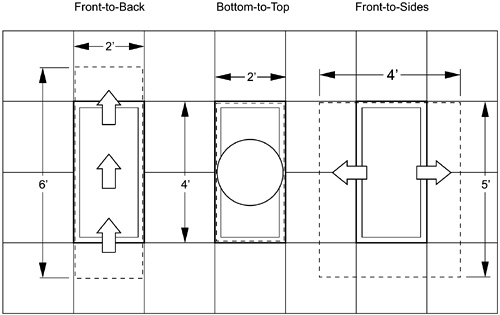Determining Criteria for RLUs
| Before discussing how RLUs are determined and used, we should examine the six criteria used in the determinations. These are power, cooling, physical space, network connectivity, rack weight, and logical capacity. The following figure shows in-feeds from power, HVAC, and network connectivity. It also shows that the other three criteria, physical space, weight specifications, and functional capacity, are aspects of the rack. Keep in mind that the specifications for these criteria should be listed for the rack or the rack's individual devices. If they are not on hand, you should get them from the equipment manufacturers. Figure 4-2. RLU Criteria PowerThe amount of power, number of breakers, and how the center is wired are all dependent on the needs of the equipment planned to occupy the floor space. When you know the power specifications and requirements of all the devices, you can do the math and begin designing the power system. You need to know the following:
The last item is best described in watts. This information should be part of the manufacturer's specifications. However, if the specifications don't tell you how many watts the device will draw, you can calculate this from the BTUs-per- hour rating of the rack. You will also need to know if the rack has redundant power. If so, all watt usage requirements must be multiplied by this value. If the rack has no redundant power, the multiplier is one; if it does have redundant power, the multiplier is two. In an RLU specification, this multiplier is referenced as RM (redundancy multiplier ). Power can be difficult to retrofit, so you should plan carefully for future power needs and install conduit and wiring adequate for future power upgrades. CoolingA rack of devices produces heat and requires a specific amount of cooling to keep it running. The HVAC requirements should be carefully planned, because retrofitting the HVAC system is no easy task. Cooling requirements are specified as BTUs per hour. This should be part of the manufacturer's specifications. If it is not, you can calculate it from the amount of watts the machine uses. At minimum, either BTUs per hour or watt usage must be available from the HVAC manufacturer. The requirement is to deliver enough conditioned air to the rack to meet the BTUs per hour requirement. For example, if you have a rack that has a cooling requirement of 10,000 BTUs per hour, and the HVAC system is only able to deliver conditioned air to this rack location at 90 percent efficiency, then it must deliver 11,110 BTUs per hour into the plenum to compensate for this inefficiency. Work with your HVAC contractor to ensure this. The amount of area (square footage) needed on the floor for each rack must take not only the actual dimensions of the rack into consideration, but also its cooling dimensions. This is the area outside the rack used to draw air to cool the internal components and exhaust this heated air out of the rack and back to the return plenum. While newer Sun racks are usually cooled front-to-back (an efficient use of space because racks can be placed side-by-side), older Sun racks and racks from other manufacturers might draw or expel air at the sides. The dimensions you use in determining RLUs should include this cooling area. The following figure shows examples of the general cooling dimensions of racks with different air patterns. These dimensions also indicate the minimum areas that should be left unobstructed by other equipment to allow for the free flowing of air. Check with the manufacturer for the actual cooling dimension specifications. Figure 4-3. Possible Cooling Dimensions (Within Dotted Lines) of Different Racks The cooling space required outside the rack can often be used as aisles and free space. In a front-to-back configuration, the cooling area would be part of the 40 to 50 percent of the total square footage needed for free space. BandwidthThe primary concern with bandwidth (connectivity) is the network and storage cabling within the data center. This is usually done with Category 5 (Cat5 - copper ) cables and/or multi-mode fibre cables. When determining the bandwidth part of the RLU, the concern will primarily be whether or not there are enough connections for the rack to interface with other devices. To effectively plan connectivity outside the data center, your ISP service bandwidth should meet or exceed the total capacity of your data center's inbound and outbound bandwidth specifications. The cost of bandwidth goes down over time, so it might not be worth over-provisioning . Putting in the best quality and sufficient quantities of cables for networking and storage up front is recommended, but it might be more cost-effective to buy switches and ports as you need them. Bandwidth within the data center is the easiest to retrofit. If you must cut costs in the design stages, cut internal cabling first. You can always add it later as budget allows. Cabling to the outside ISP should be done correctly in the beginning because changing this cable is costly (sometimes involving ripping up walls, floors, digging trenches, etc.). WeightIt is critical that you know not only the individual weights of each type of rack that will reside in the data center, but the combined weight of all of them. With this knowledge, and some forethought as to the future weight that will be added, you can decide whether the existing floor can handle the load. Or, if you are building to suit, you can plan for a subfloor and raised floor that will exceed the weight demands. Each distinct rack has a specified weight. This weight is generally the same for all racks of the same manufacturer and model, but could change due to additions or subtractions to the configuration. The exact weight, or the potential weight of the rack, should be used in the calculations to ensure a floor that can handle the load. There are a few different floor load capacities to consider:
Load capacity is probably the most difficult of the criteria to retrofit later. Imagine trying to keep the data center up and running while replacing a raised floor. Concerns About WeightThe most overlooked area in data centers is floor load ratings. We've now reached a point where high end systems and storage racks are starting to put a strain on existing floor load ratings and the problem is going to get worse . As we get more density in a smaller space, the per tile weight requirements go up drastically. Flooring systems designed for clean room applications are finding their way into data centers, specifically for these reasons. For example, Interface Inc.'s Tri-Tec floor system has a 55 percent pass-through grated cast aluminum tile that can handle a total load of 1,750 PSI. Budget is often a major factor in determining what type of raised floor you install. In some data center applications, using the same raised floor throughout makes sense. However, there are areas, such as high value storage areas, electrical rooms, or areas with lighter equipment, that might not need such high floor load capacities. For example, the Sun Netra X1 server weighs 6kg or 13.2 lbs. A single rack with 30 Netra X1s would weigh less then 500 lbs, and that's assuming the rack itself weighs 100 lbs. A Sun Fire 6800 server weighs 1000 lbs. And the Sun Fire 15K server tips the scales at 2200 lbs (yep, that's one metric ton!). Now, if you know that you'll have areas with smaller floor loads, you can use a lower rated floor in that area and save some money on the budget. However, you have designed in a restriction so that equipment in that area cannot exceed a specific weight. If you decide to split up the weight load of your data center floor, you must also consider the pathway to the higher load area. The heavier rated floor should be the one closer to the entry point. It's poor planning to construct a higher rated floor on the far side of your data center, and a lower rated floor between that floor and the access point, because equipment must be transported over this space. Physical SpaceThere are essentially three aspects of physical space to consider when determining the area requirements for a rack:
Functional CapacityFunctional capacity is required only to determine the quantity and type of RLUs you will need to meet the project scope. For example, a Sun StorEdge T3 array might contain 36 gigabyte or 73 gigabyte drives. A fully configured rack of Sun StoreEdge T3 arrays with 36 gigabyte drives has a functional capacity of 2.5 terabyte. A fully configured rack of Sun StoreEdge T3 arrays with 73 gigabyte drives has 5.2 terabyte functional capacity. So, if your project scope specifies 100 terabytes of storage, you would need only 20 Sun StoreEdge T3 arrays with 73 gigabyte drives. Forty would be needed if 36 gigabyte drives are used. Knowing the functional requirements of the data center falls into the realm of capacity planning which is not usually the role of the data center designer. For in-depth information on capacity planning, the following two Sun BluePrints books are recommended: Capacity Planning for Internet Services by Adrian Cockcroft and Bill Walker, and Resource Management by Richard McDougall, Adrian Cockcroft, Evert Hoogendoorn, Enrique Vargas, and Tom Bialaski. Also recommended is Sun Performance and Tuning (Second Edition) by Adrian Cockcroft and Richard Pettit. These books offer excellent information on capacity and performance issues that you should know to do accurate capacity planning. See Appendix B, "Bibliography and References" for more information. |
EAN: 2147483647
Pages: 142

